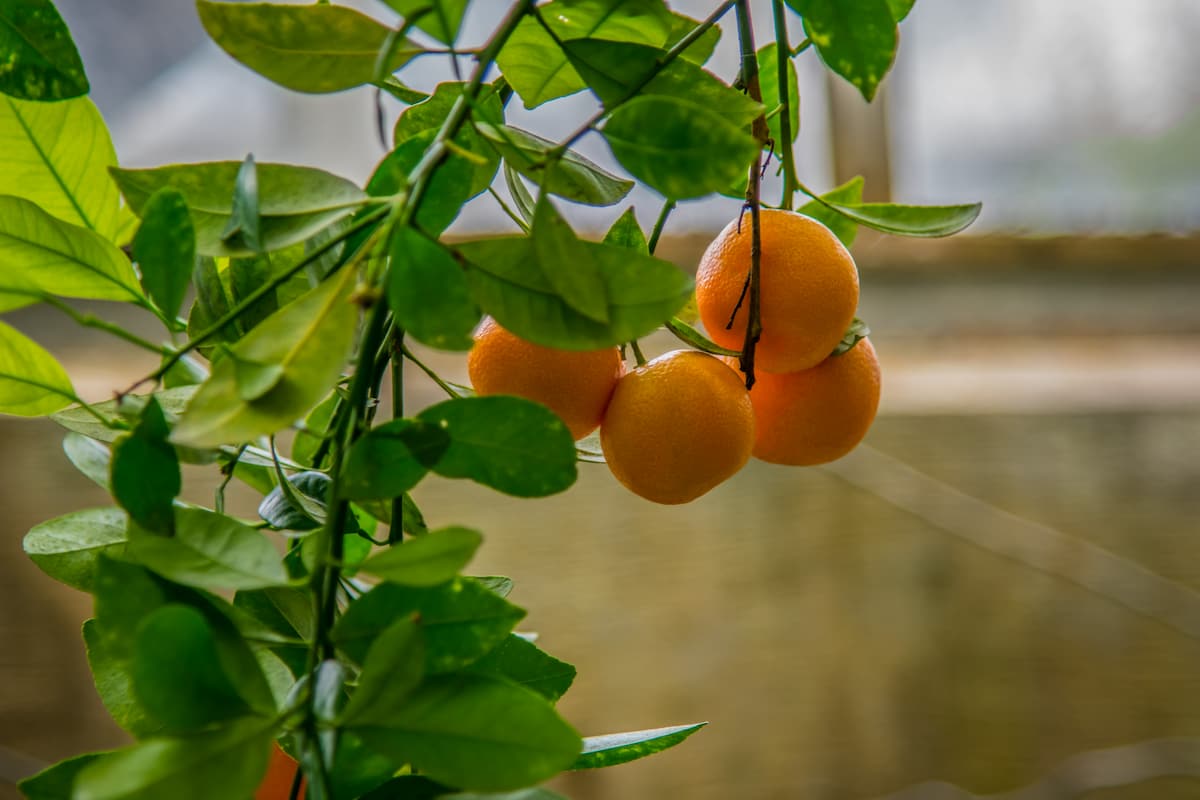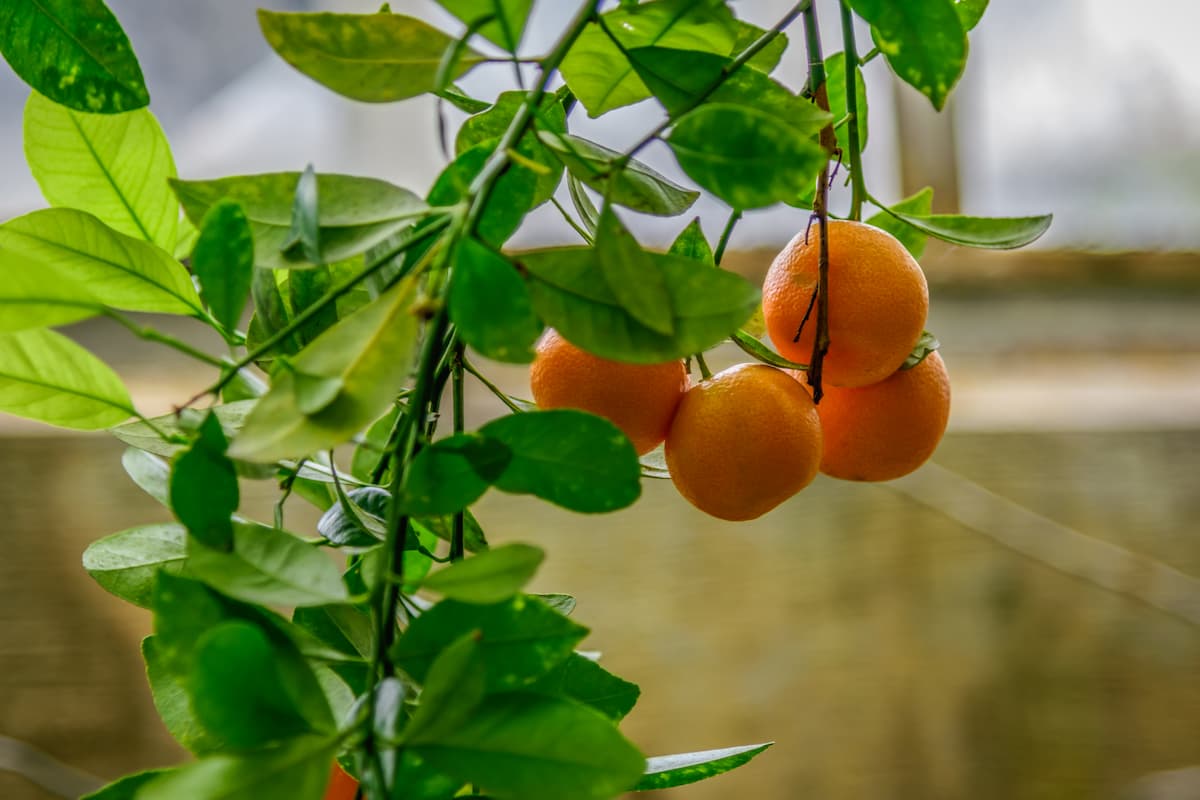Orangeries were traditionally greenhouses used for growing citrus trees. Historically, these greenhouses were used to grow oranges, exotic fruits enjoyed by the wealthy. Despite its modern status, an orange imported from Spain is still regarded as a symbol of wealth in many ways. It is easier than ever to grow oranges in a greenhouse. However, before you plant citrus trees in your greenhouse, you should consider different varieties and the size of your greenhouse versus the size of your citrus tree.

How to Grow Oranges in a Greenhouse
Orange Varieties Suitable for Growing in Greenhouse
You can grow dwarf varieties of sweet oranges and blood oranges (Citrus sinensis). A sweet orange, such as a navel or a Valencia, produces tasty fruit that you can find at the grocery store. Especially along the coast, the Skaggs Bonanza navel produces early fruits. A Valencia orange can ripen for up to six months, making it an excellent juicing orange.
It is common to use blood oranges, including Moro and Sanguinelli, to produce vibrant, flavorful juice. During the day, warm conditions sweeten the fruit, while cool conditions enhance its deep red colour at night. Sanguinelli blood oranges are tart and spicy, while Moro blood oranges have a berry-like flavour.
Soil Requirement for Growing Orange Trees in the Greenhouse
Loamy, rich, well-draining soil is ideal for orange trees. Draining excess water from the soil is important, as orange trees cannot tolerate wet, heavy soil. Planting these trees with potting soil will provide them with additional nutrients. A pH level of 6.0 to 7.0 is ideal for soils that are slightly acidic to neutral.
Sunlight Requirement for Growing Orange Trees in the Greenhouse
The orange tree is a citrus cultivar that thrives in areas with a subtropical climate. Standard and dwarf orange trees thrive in full sunlight but can tolerate some shade. Even if they bask in the sun all day, they can still stay healthy if they get six to eight hours of sunlight exposure daily. Sunlight makes orange trees healthier, thickens their foliage, and increases fruit production.
Temperature and Humidity Requirement for Growing Oranges in the Greenhouse
Temperatures between 16 and 32°C are ideal for growing orange trees. This applies to both ground-grown and potted trees. However, there is a relationship between cold tolerance and the type of orange tree planted. Citrus trees also prefer a humid atmosphere of about 50% and warmer temperatures. A humidifier or greenhouse misting system can increase humidity in your greenhouse if you live in a dry climate or experience dry winters.
How to Grow Orange Trees from Seed
While orange trees can be grown from seeds, it is important to note that seeds might not produce trees identical to their parent plants. You need a bowl of water, a tray or small pot filled with rich potting soil, and a plastic bag to start a tree from seed. Here are the steps to follow:
- The seeds should be soaked in a water bowl for at least 24 hours before planting. Don’t plant seeds that float (they aren’t viable); only plant those that stay below water.
- Plant the soaked seeds about 1 inch deep in the rich potting soil.
- Ensure the pots are placed in a warm environment and moist soil. The plastic bag should be placed over the pot to maintain high humidity. Check the soil moisture daily and allow the bag to breathe.
- You should remove the bag once the seeds have germinated.
- Place the seedlings in an area with bright light. It may be necessary to use grow lights.
- Each seedling should be transplanted into its container and kept in bright light.
In case you missed it: How to Grow Mangoes in a Greenhouse: A Step-By-Step Guide for Seed to Harvest

Water Requirement for Growing Oranges in the Greenhouse
Since orange trees dry out much faster in pots, watering them is very important. Too much water is bad for orange trees. Summer watering, although necessary, should be reduced and regular, not abundant. It would be best to water in the evening so that water does not evaporate quickly.
Fertilization Requirement for Growing Oranges in the Greenhouse
Depending on the use of the fruit, different nitrogen fertilizers result in more oil in the peel of orange trees. The amount of oil in the peel decreases when potassium fertilizer is applied. Each tree should receive 0.5-1 kg of nitrogen annually for high productivity of edible oranges. Various micro-nutrients should be included in fertilizers, as well as potassium and phosphorus. For older orange trees that don’t produce fruit in abundance, you should conduct a soil test in the area where they grow to determine what fertilizer ratios they require. Tree leaves are often sprayed with additional fertilizer once or twice a year.
Pruning Oranges Trees Growing in Greenhouse
When you want to grow fruits on your trees, pruning is essential. It would be best if you pruned during February or March. Cut back in-growing branches that block light from entering the tree’s interior. You should also remove the branches that cross over one another. Trees should be pruned lightly to maintain their structure.
Common Orange Tree Pests and Their Control
Fruit of orange trees should be monitored for pests that can damage them. Several pests can affect the health of a tree, including aphids, mites, leaf miners, earwigs, and scales. For these problems, organic solutions include using natural predators such as ladybugs around the tree to keep the bark clean from aphids or spraying young leaves with neem and citrus oil to repel mites.
Infested branches can be manually treated with pruning shears sterilized between cuts, earwigs, or leaf miners removed. The best way to combat scale insects is to spray insecticidal soap three times a week for three weeks. It is important to take control measures to ensure your orange tree grows healthy organic fruits and avoids major problems.
Common Orange Tree Diseases and Their Control
There are many dilemmas farmers face when it comes to orange tree disease. Several conditions can cause orange tree diseases, such as citrus greening and blight. Citrus trees cannot produce healthy fruit due to a bacterial infection that causes citrus greening. If left uncontrolled, blight can destroy entire groves due to an airborne bacteria that spreads from plant to plant. Diseases can be treated and prevented with various methods, such as keeping trees pest-free, fertilizing them throughout the year, pruning at specific times, providing adequate water drainage, and using mulch around their roots.
Harvesting Greenhouse Grown Oranges
Picking citrus can be tricky if you don’t know when to do it. Ripe citrus fruit is usually heavier, brightly coloured, and gives a little when you press it with your fingers. Once picked, oranges won’t continue to ripen, so you should err on caution if you aren’t certain they are ripe. When it comes to juice oranges, remember that the longer they are on the tree, the sweeter and juicier they will be.
In case you missed it: How to Grow Papaya in a Greenhouse: A Step-By-Step Guide for Seed to Harvest

Conclusion
The delicious and nutritious fruit of orange trees is now grown worldwide. Growing citrus trees in greenhouses are generally easy and yields the freshest fruit possible. Oranges are a great example of this. Oranges grown in greenhouses are unlike those found in supermarket produce bins once you have tasted them.
- Feed Your Flock for Less: Top 10 Tips to Save on Chicken Feed
- Ultimate Guide to Ossabaw Island Hog: Breeding, Raising, Diet, and Care
- Hatching Answers: The Top 10 Reasons Your Chickens Aren’t Laying Eggs
- Eggs and Economics: Breaking Down the Cost of Raising Backyard Chickens
- Defend Your Greens: Proven Methods to Keep Iguanas Out of Your Garden
- Ultimate Guide to Cinnamon Queen Chicken: A Comprehensive Guide for Beginners
- Ultimate Guide to California Tan Chicken: Breeding, Raising, Diet, Egg-Production and Care
- Ultimate Guide to Marsh Daisy Chicken: Breeding, Raising, Diet, and Care
- 10 Types of Chicken Farming Businesses You Can Start for Profits